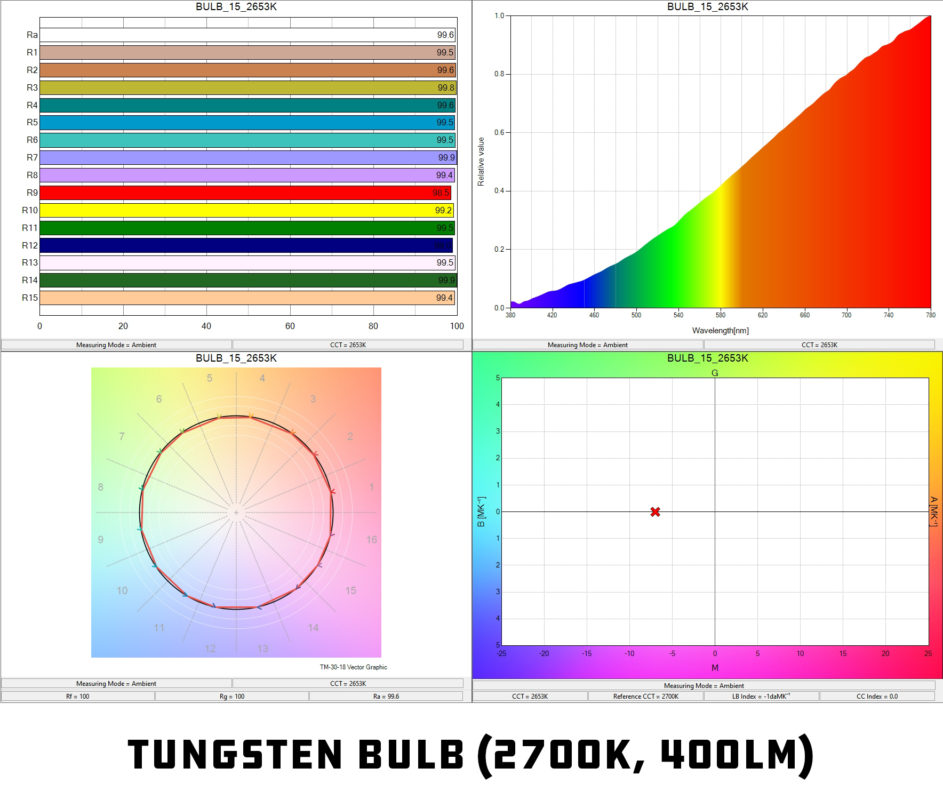In almost every application, LED lighting has fully taken over. You can’t even buy Tungsten Filament bulbs in California anymore aside from specialty applications like appliance bulbs or photo floods. Every bulb in your house is likely an LED (or a “pigtail” CFL if you haven’t swapped those out in a few years) and the Film Industry is no different; pick a set, you’ll find an LED fixture.
Roger Deakins famously uses regular Tungsten bulbs in a large “Ring Light” from time to time, built simply out of a bunch of porcelain sockets fixed to a wooden or aluminum hoop to give off a really nice, soft, warm light. He’s also gone so far as to build the same apparatus out of 256 ARRI 300-watt Fresnels for Blade Runner 2049. People talk about this Ring Light all the time here on the internet and that got me thinking: is that quality of light even possible with LED bulbs?

You see, LEDs are not a great replacement for traditional Tungsten bulbs, color-wise. They’re insanely more efficient, generally made of plastic and therefore more robust, don’t get hot, and last for thousands and thousands of hours so there’s a lot of benefits to using LED bulbs, especially in household applications, but one thing that LED technology has yet to come up to speed with is simply matching the spectral output of traditional sources. It took forever just to make decent warm bulbs! For the longest time Daylight-balanced LEDs were the only thing you could sort of reliably… rely on.
At the beginning of the year I got myself a Sekonic C800 and was metering damn-near everything I could find. I’m fascinated by gathering information, like a proper nerd, and being able to evaluate light sources in an objective way is, for me, crucial in executing my duties as a DP. If I want to achieve certain looks (or more importantly avoid cheap ones) I need to know as much as I can about the light I’m deploying in the scene!
So swinging back around to the “Deakins Ring”, I had made a small one, about 12” across, composed of 7 bulbs (pictured below) maybe a year ago and it does a great job of putting out a decent amount of light in a small-yet-soft package. I did some basic research and found some CREE bulbs that seemed to do the job of giving me a soft, warm light without any ugly spikes or weird color shifts. But I didn’t know that. I was taking someone’s word for it! So I had to get down to the bottom of it.
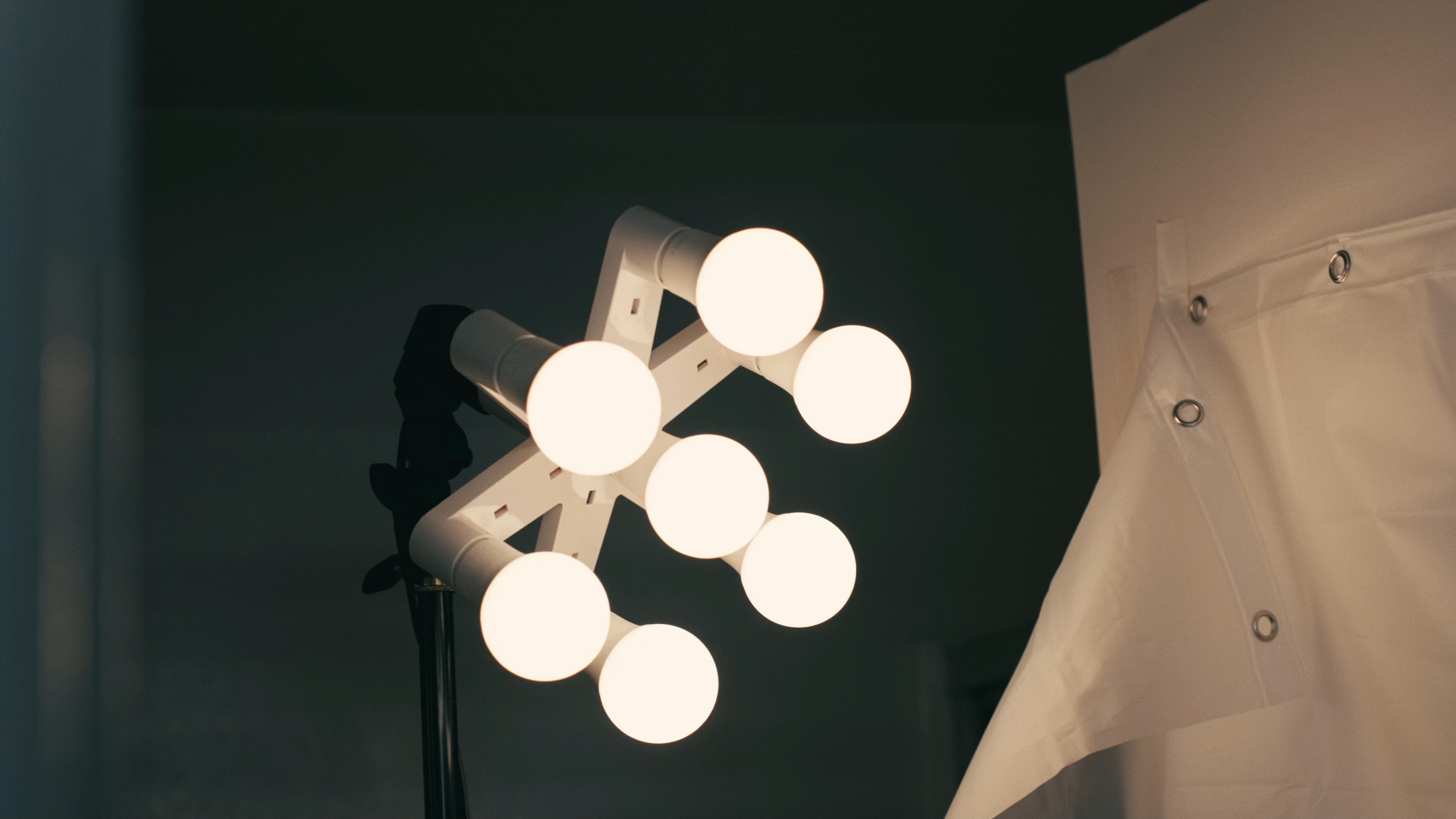
With modern cameras being so sensitive these days, I figured it’d be worth seeing whether or not household bulbs can once again be used in a cinematic context. Obviously we’ve used them in practicals before, but can we use bulbs found in the “Household Goods” aisle as film lights as well?
What I’ve done, for your evaluation, is gone to a few local stores and grabbed 15 bulbs off the shelf. These are bog-standard consumer lights. I didn’t go to a Hardware Store just because I know I’d have way too many options and would end up spending hundreds or even thousands of dollars just for this test (if someone wants to sponsor that endeavor, I await your email) so I simply hit up IKEA, Amazon, and Ralph’s (Kroger), as well as went around my own home and grabbed all the random bulbs I could find. I went into a dark room and held the bulb about 18” away from the meter for each measurement. Below are my findings, starting with a Tungsten and Daylight reference, and be sure to read my article about the various metrics used here to get a better idea of what’s going on:
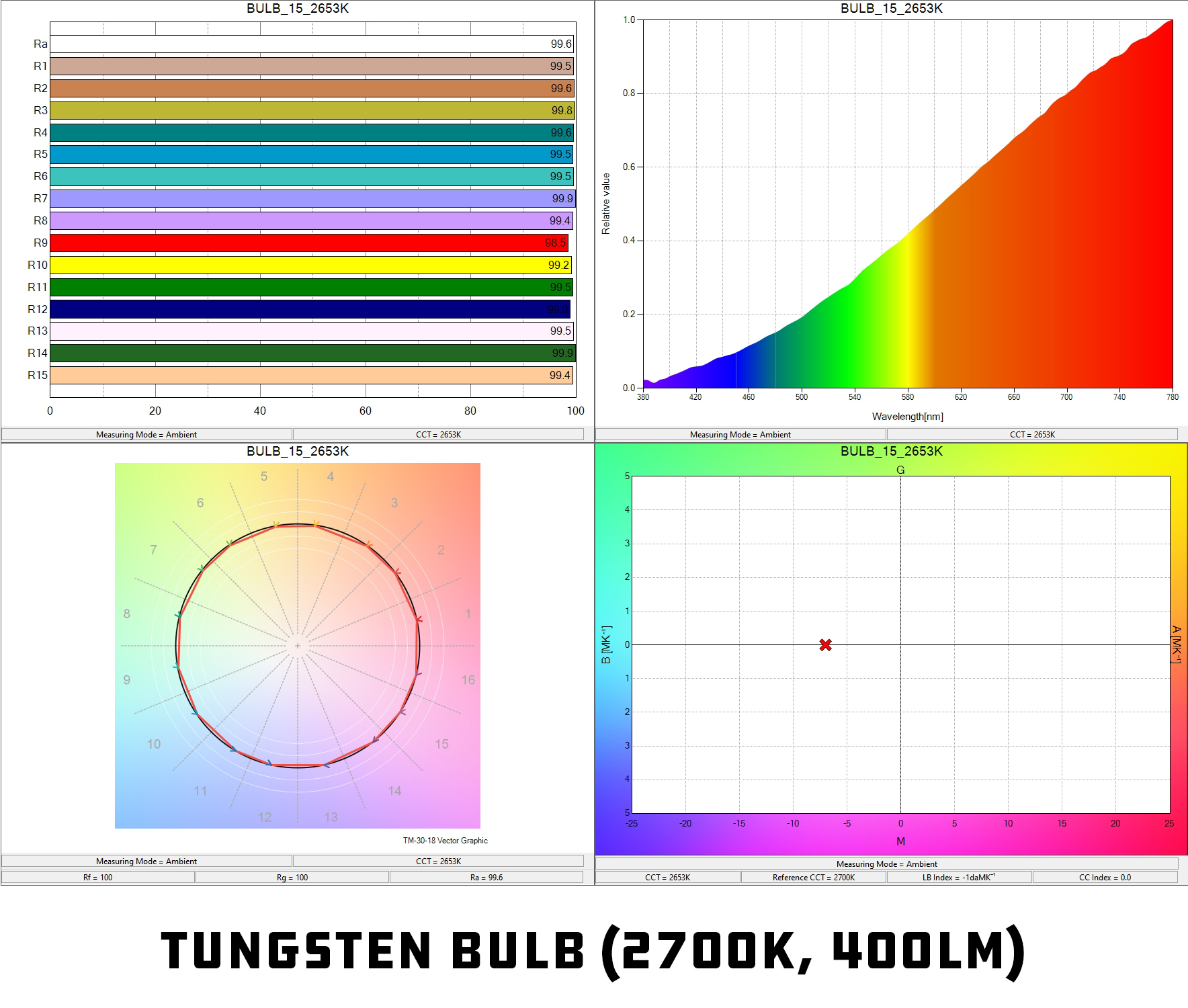
I actually found this bulb at Ralph’s. It’s an appliance bulb intended for use inside an oven and is a true Tungsten filament bulb. As you can see, the CRI (the Ra value) is essentially pegged at 100 across the board, the spectral output is a smooth gradient from very little blue to 100% red, and the TM-30 (the lower left circle) shows us that there’s very little if any “hue skew” giving us values of 100 for both Rf (0-100 scale, 100 being “most accurate” similar to Ra) and Rg (60-140 scale, 100 being neutral, and above/below that representing it being desaturated/oversaturated respectively). CRI is kind of an old standard which doesn’t evaluate enough of the light’s spectral output, so these days we want to use TM-30 and/or TLCI. I’ll be listing the TLCI here in the comment sections of each bulb which for this bulb, shocker, was 100. As with Rf, the TLCI scale is from 0-100 and represents how accurate a light is based on a camera’s observation of it, versus CRI which is based on human vision (which is kind of irrelevant to filmmaking, in the strictest sense, but also like I said isn’t even very thorough).
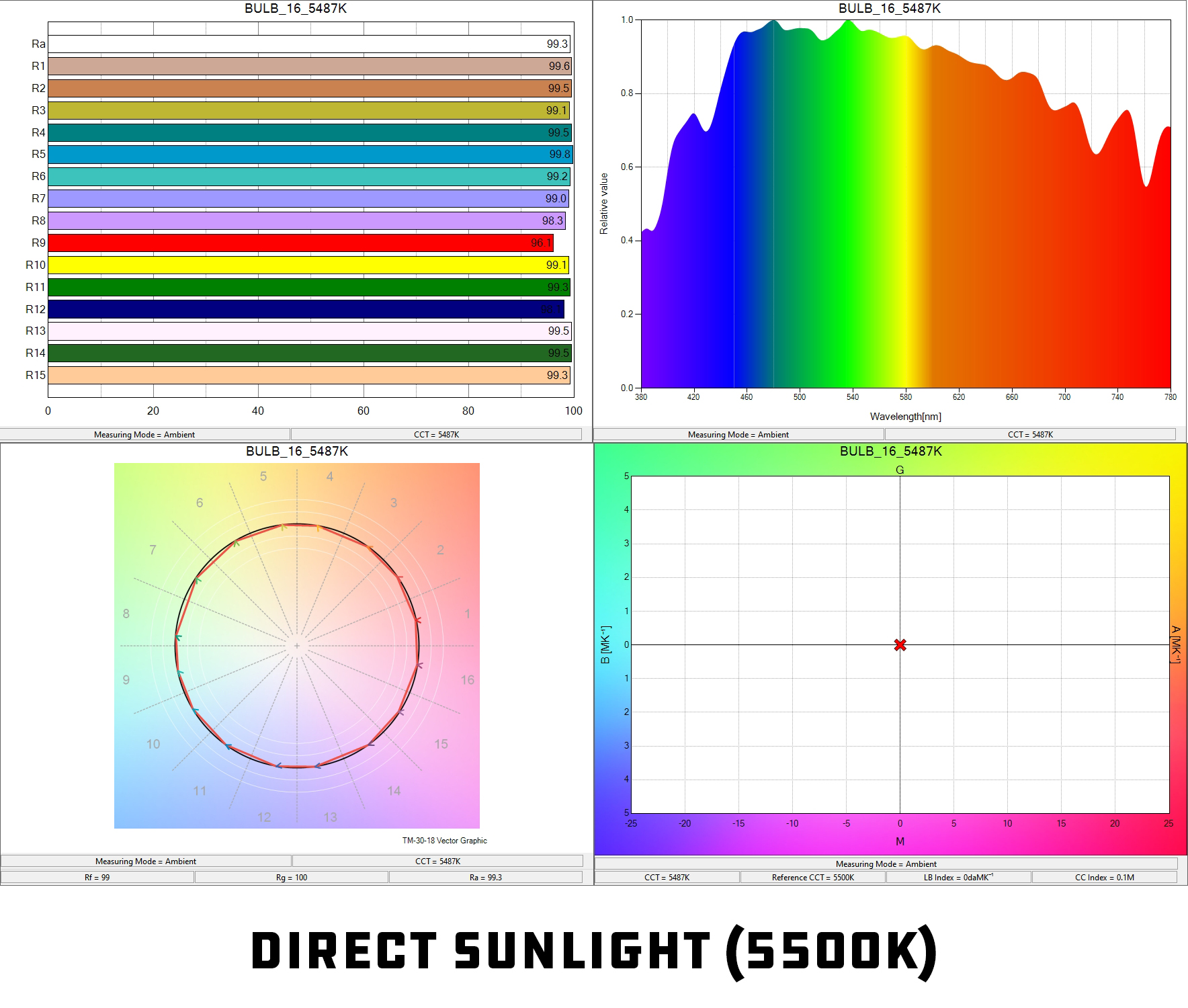
Here we’ve got Sunlight, as measured on a completely clear day here in LA, and as we can see we’ve got nearly the same values as the Tungsten bulb, although the Sun does appear to be filtering through the atmosphere a little and not giving us the smoothest spectral output. The sun can vary wildly in color temp and “correctness” based on where you live, which is why it’s nice to have one of these color meters because if you’re trying to match the sun coming through a window with a Skypanel, for instance, and you just set the thing to 5600K… is that accurate?
What if the sun is kinda low and it’s more in the 5000K area? What if it’s early morning and it’s actually 4500K!? And how do you know the Skypanel is putting out 5600K when you set it to 5600K? Well with a color meter you can test that, and with some LED fixtures you can use X-Y coordinates that you put in that, once you get those values from a reference source, should exactly match said source. For your edification, the X-Y Coordinates for that Tungsten bulb above are 0.4643/0.4124 and the sunlight sample is coming in at 0.3328/0.3458. Moving on!
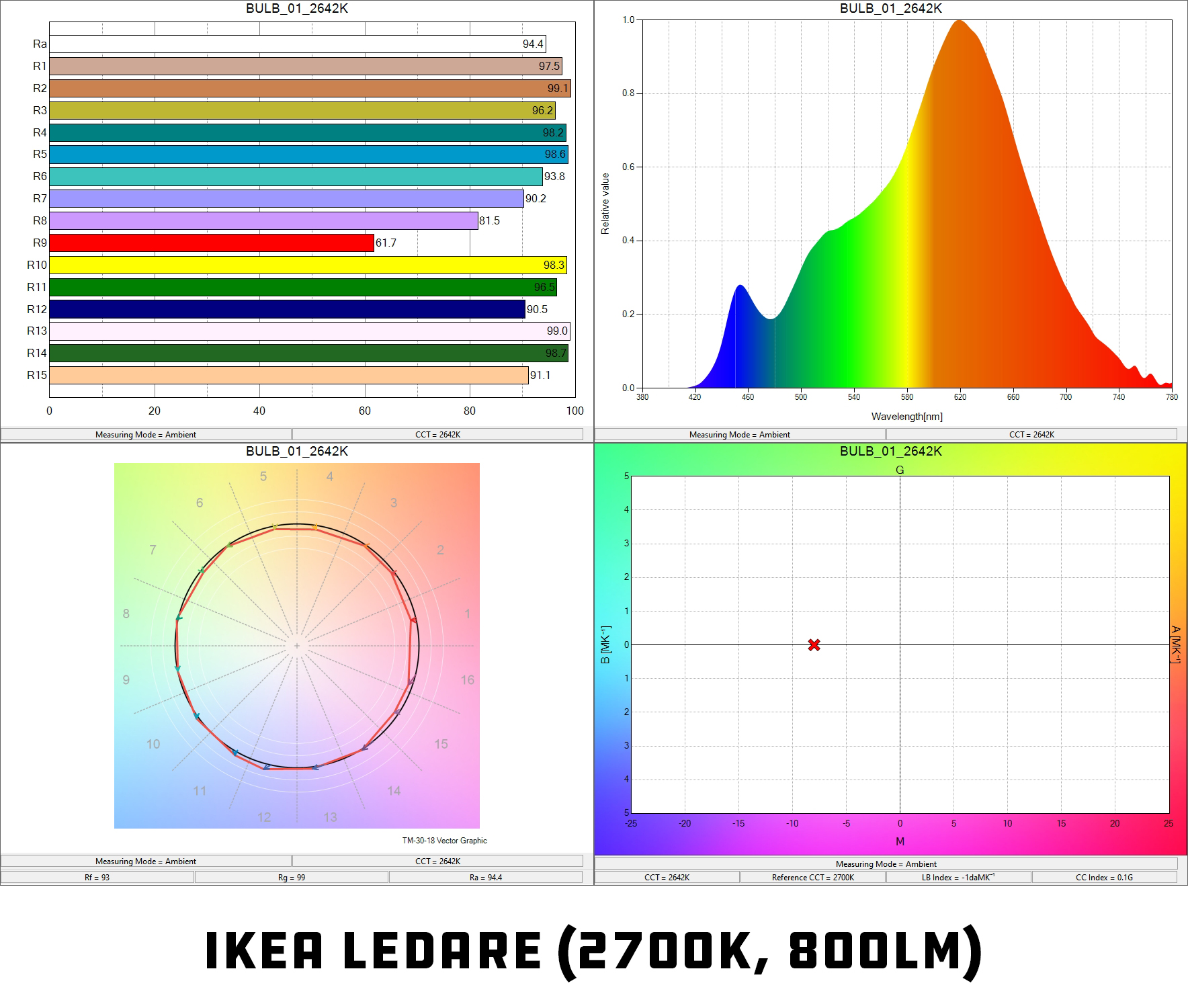
Our first bulb is an IKEA LEDARE, which I was told was pretty accurate. As we can see, and what will be the case going forward, the spectral output isn’t a smooth gradient from blue to red like our Tungsten reference, and is a little more orange than red overall. We’ve also got a touch more green and a small spike of blue. That “R9” value everyone always talks about is also lower than I’d like to see. But, that being said, we’ve got an Rf of 93 and an Rg of 99 and the color temperature is only 58K off, so that’s not horrible. This, however, highlights why we need more modern color meters because while the CCT is nearly spot-on, the actual spectrum of light that’s being output is not the same.
The TLCI of the IKEA LEDARE is 90, which is the bottom of what I’d want to see in a bulb used for filming. Technically the TLCI people say 85+ would require no color correction, but I like to see 9’s in my results. The SSIt (Spectral Similarity Index, Tungsten) is 81, which means on a scale of 0-100, this bulb is “81” similar to a true Tungsten bulb. SSI was invented by The Academy to compare sources, and is probably the “truest” way to figure out if a bulb is going to look the way you want (assuming you want a standard Tungsten or Daylight source, but you can just compare any old sources against each other if you’re trying to match one to the other).
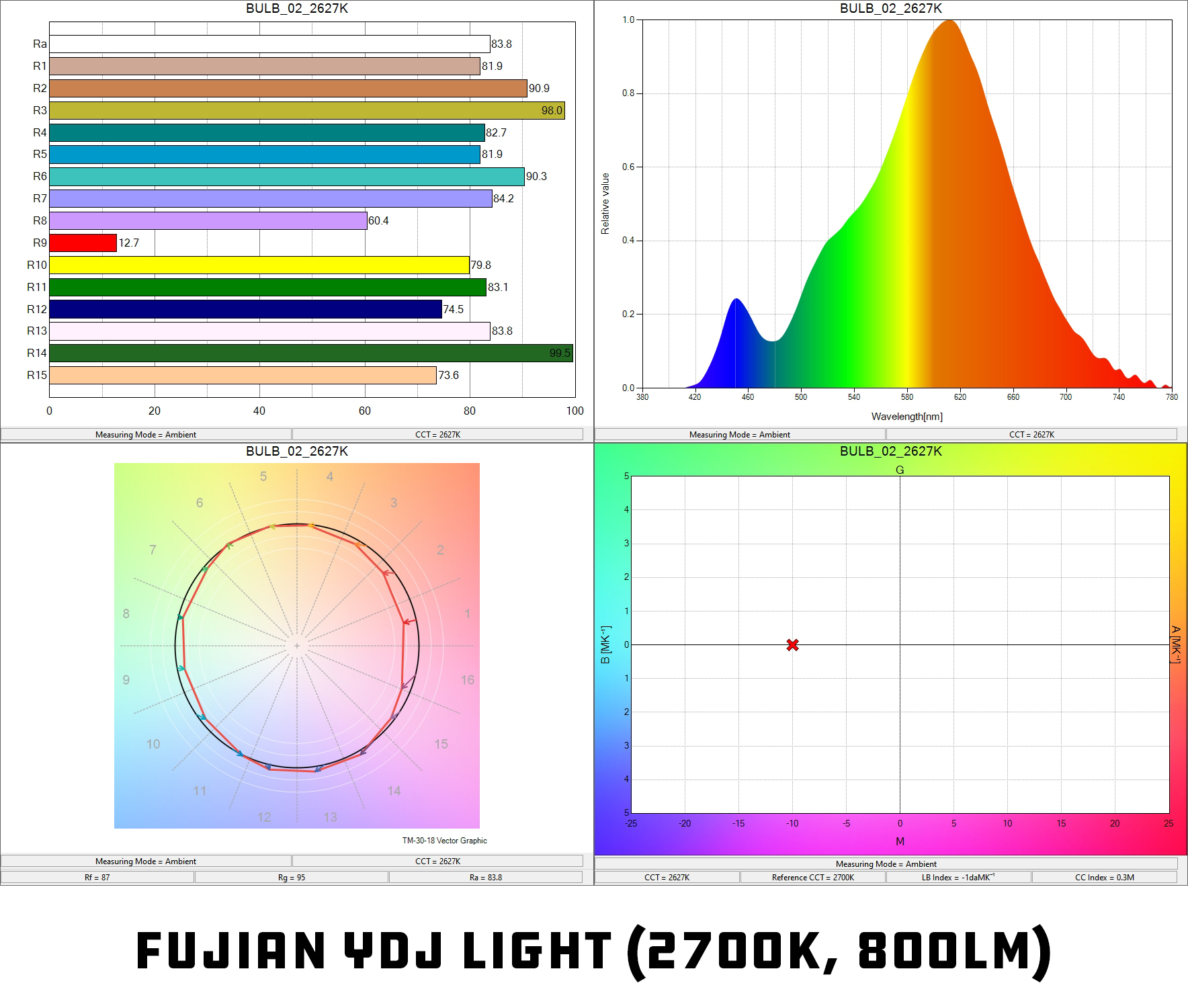
This bulb is pretty rough. I found it in a drawer and I don’t know where it came from, but as you can see the results are less than ideal. The spectral output is almost the same as the Ledare above, but the CRI is all over the place (you only have to worry about CRI when it’s bad) and the TM30 chart is looking squishy with an Rf of 87, which is below where I’d want to be. I wouldn’t even want to use this bulb in my house if I’m honest.
The TLCI of the YDJ Light is 72 and the SSIt is 75. Ouch.
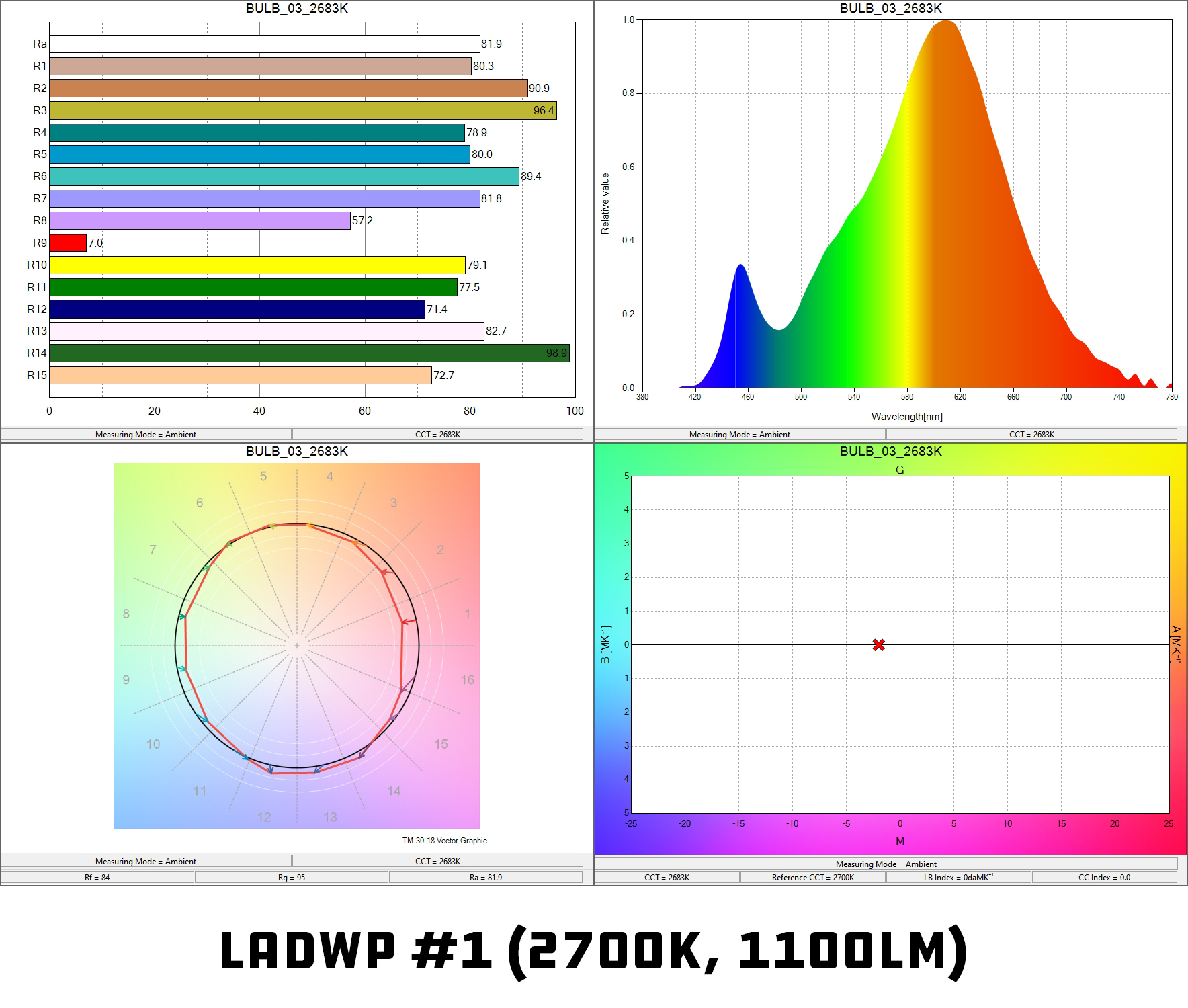
This bulb was sent to me by the good ol’ folks at the LA Department of Water and Power. They’ve sent the residents of LA a few bulbs over the years (I’m wondering if the YDJ bulb is one of them, but this one is actually marked “LADWP”) and as you can see… it’s bad. Bright! But bad. An Rf of 84 and a CRI of 82 make it a nearly immediate no for me, but the TLCI of 68 seals the deal. The SSIt of 75 doesn’t help. That’s a no thanks, LADWP. Love your work though.
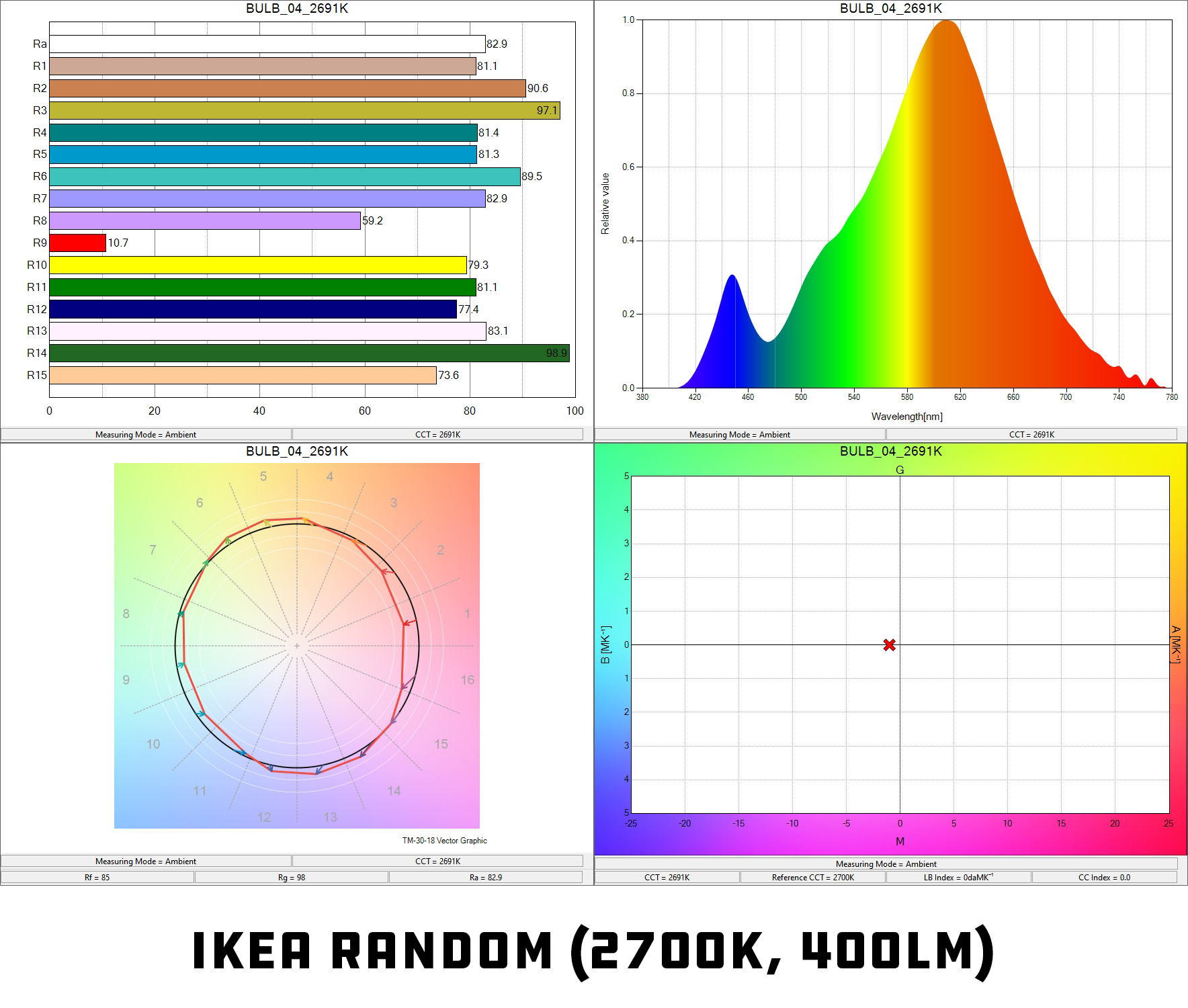
This is another IKEA bulb I had laying around the house (maybe a Ryet?) and it’s in bad shape. This one is pretty old, and as we can and will see IKEA has upped their game, but if you’ve got any of these laying around your house from maybe like 5 years ago… time to switch it up. With an SSIt of 77 and a TLCI of 66, this one is near the bottom of the barrel.
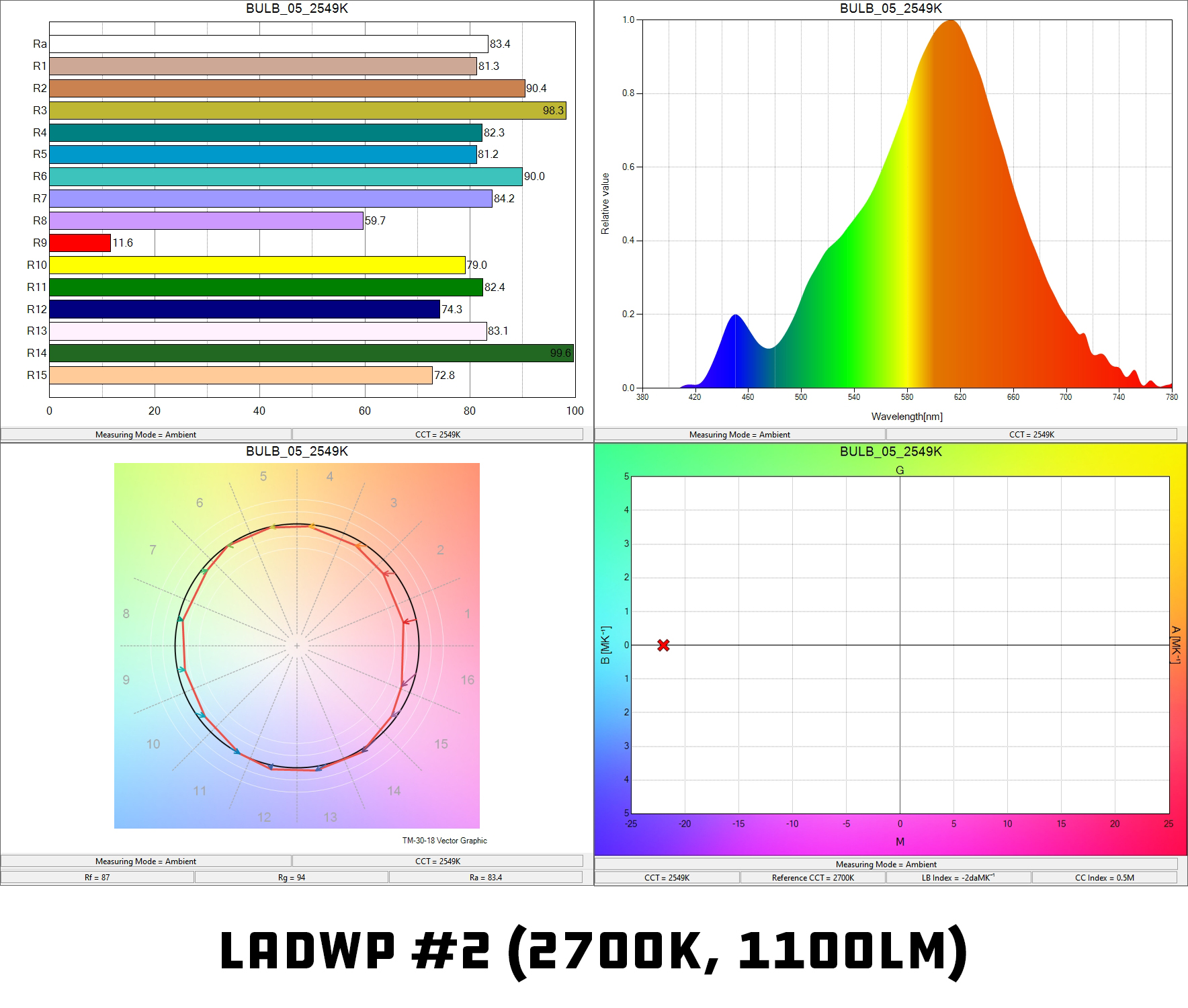
LADWP tried again and have only improved marginally, inching an extra 3 Rf points, 1.4 CRI, and 4 TLCI out of the bulb. Near as makes no difference. Also it’s nearly 200K off it’s target color temperature!
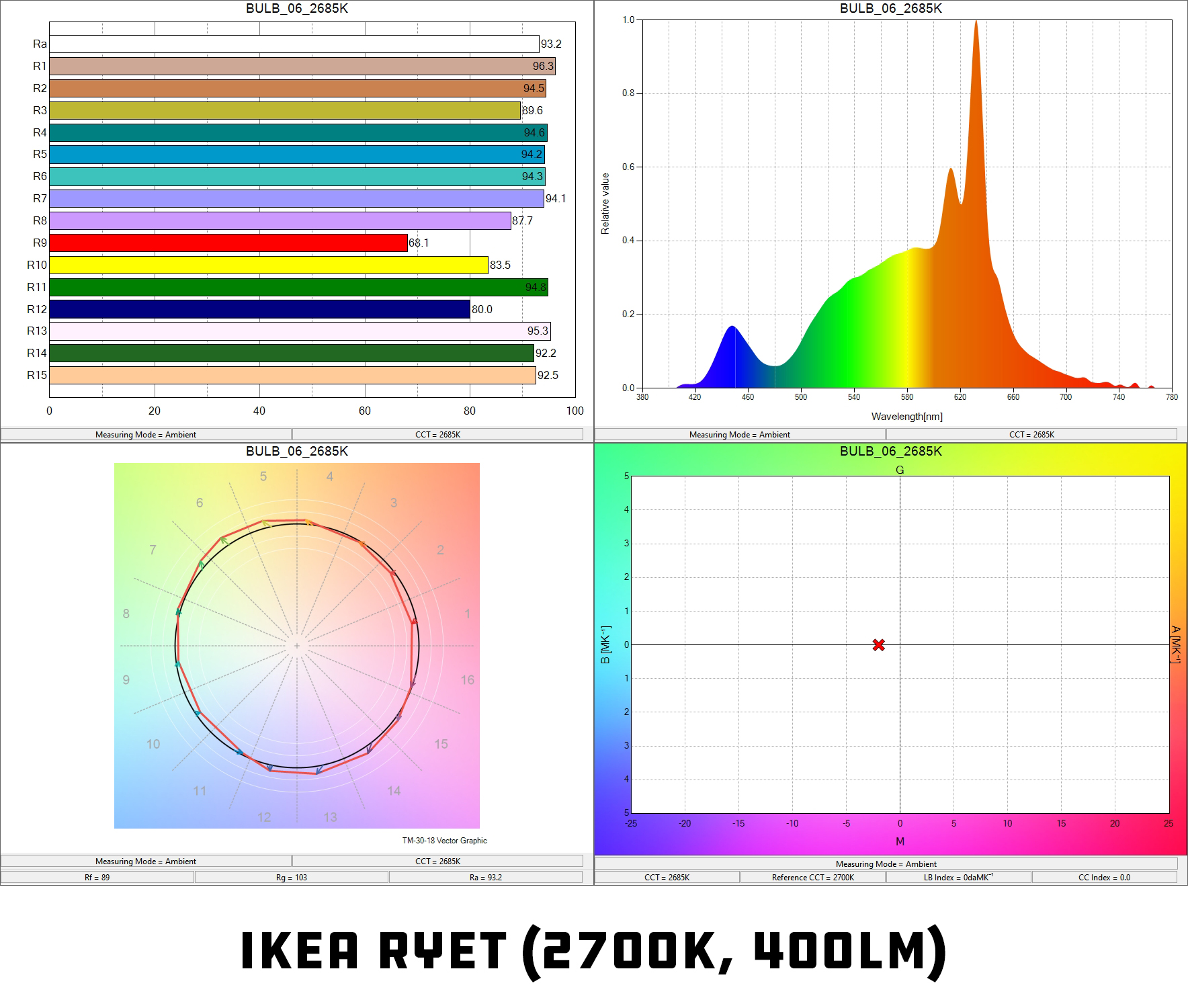
This is an IKEA RYET I just recently bought and this one’s got a new problem. Look at that spike! While it’s in the area we’d theoretically want it to be, instead of green or blue, it’s a spike nonetheless and the rest of the output is woefully low. We’re not getting a nice smooth spectrum of light from the bulb, instead it’s acting almost like an orange party light or something, and that’s not what we want. If you’re going the IKEA route, definitely get the LEDARE.
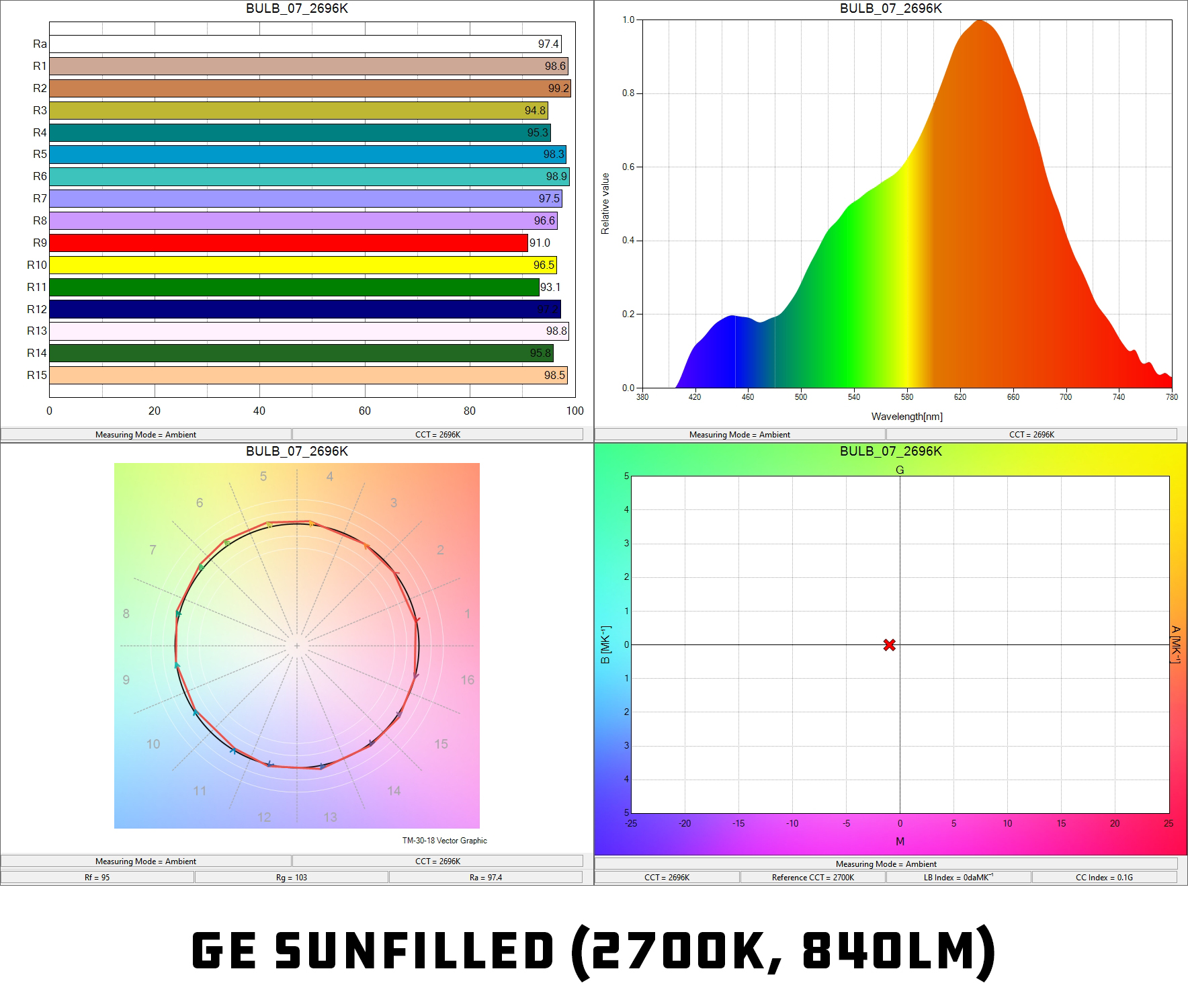
Now this one is interesting, because I recently saw GE puffing their chest about having these newly-designed bulbs that are better than all the rest due to a lack of blue spike in the spectrum and being more accurate to daylight (or Tungsten, I guess, since they offer both). I think I saw that press release the day they put it out, so being the “oh yeah, prove it” kind of person I am, I immediately went and found myself one of each to test. Lo-and-behold, they’re not lying! There’s definitely less of a blue spike than all the other LEDs on this list (the intent of which, according to GE, is to help regulate sleep since blue light keeps us awake) and they’ve accurately delivered on their target CRI of 97. With a TLCI of 95, an Rf of 95, and a SSIt of 86, this bulb is definitely a great option for budget film lighting. Also, it’s nearly bang-on the 2700K target, only off by 4 Kelvin! Really impressed there.
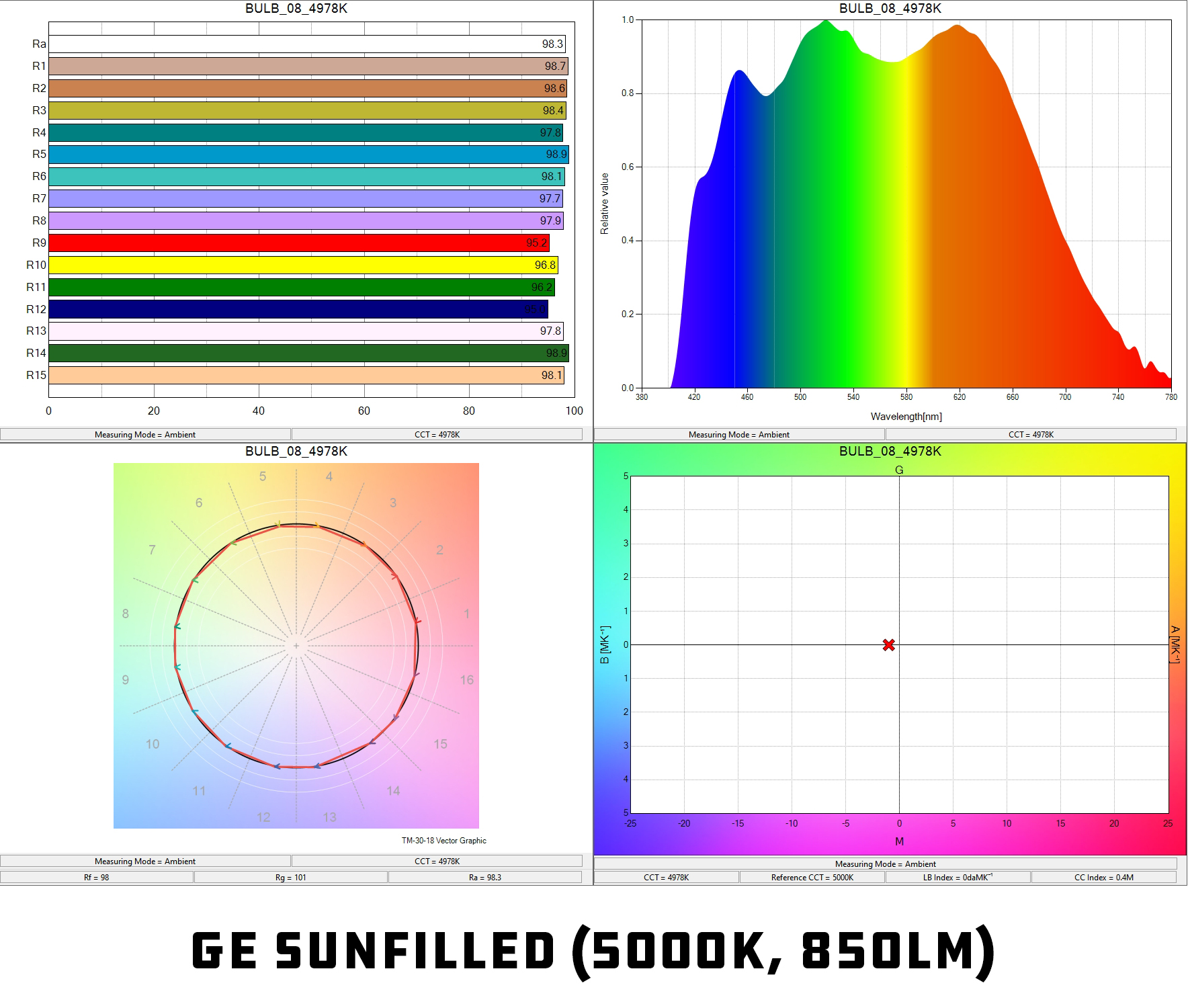
This is the Daylight-balanced Sunfilled bulb and the story is nearly the same as the Tungsten one, doing a decent job of matching the spectral output of the Sun with a SSId of 84, and the TLCI is a whopping 99. With an Rf of 98, CRI of 98, and the TM30 chart looking nice and smooth, this one is potentially an even better option than it’s Tungsten counterpart, assuming you need a 5000K source (you still have Gels though, right?).
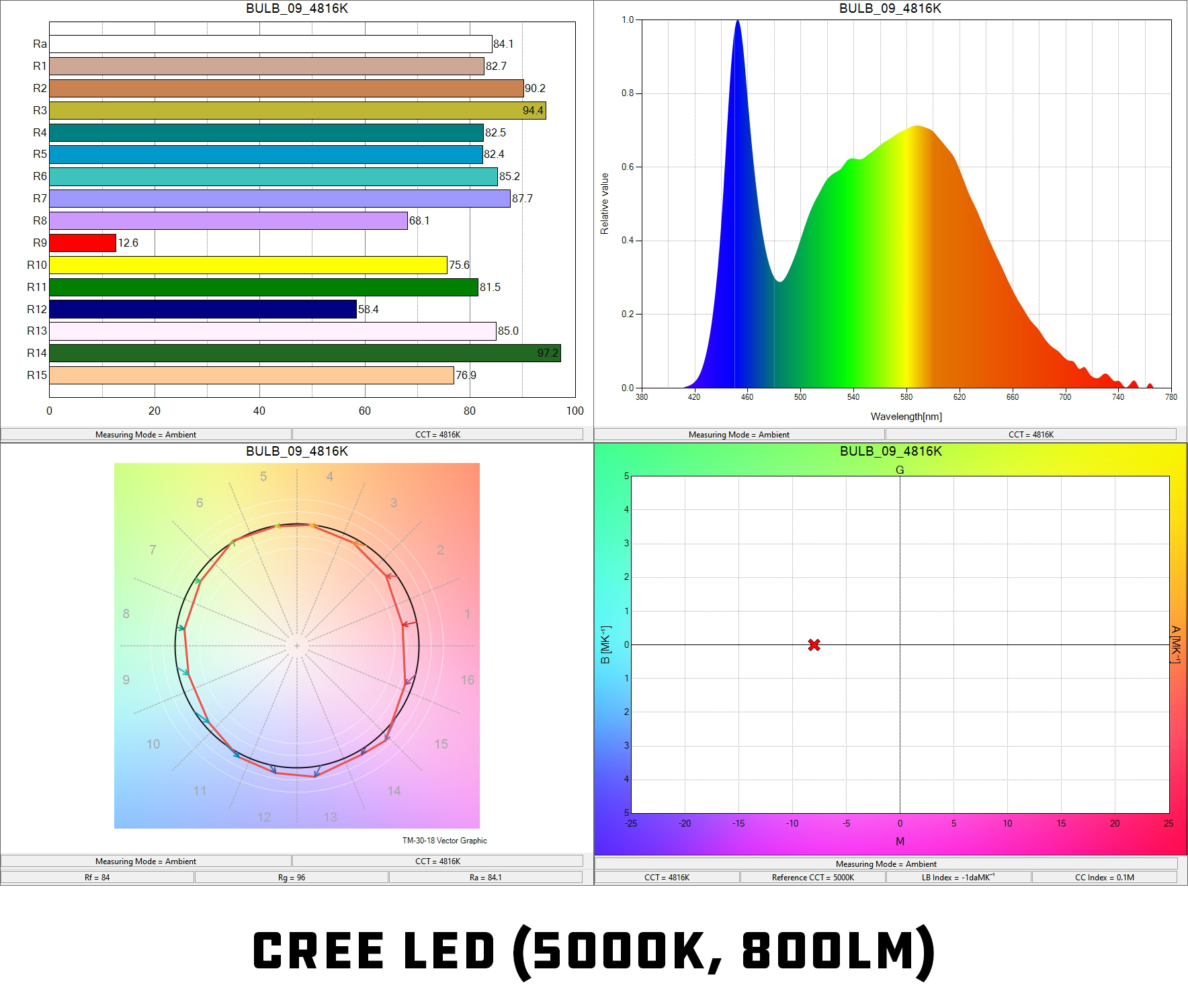
Oh no, CREE! What happened!? 200K off its target temperature, a TLCI of 70, an SSId of 66, and an Rf of 84… that’s a no for me. I feel like I should say here that there are way, way worse bulbs out there (I measured one as an example in my aforementioned article about these metrics we’ve been using to evaluate the bulbs) but as far as this grouping is concerned, the CREE Daylight bulb isn’t performing how I’d hoped. Especially in comparison to its Tungsten counterpart. Look at that massive blue spike!
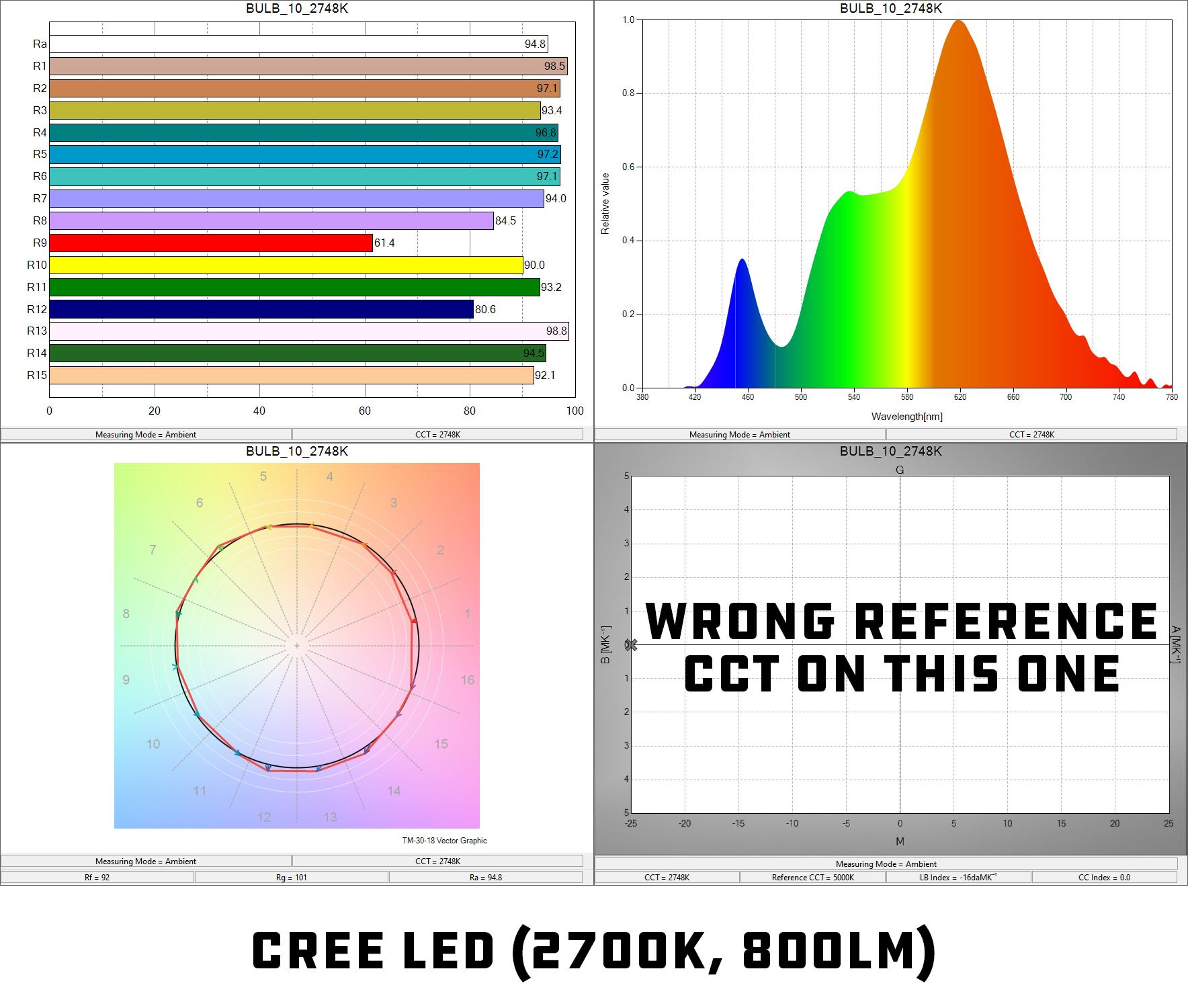
This bulb is much better. As we can see the TM30 chart is relatively smooth, the temp is only 48K off the target, and our CRI is a decent 95 (low R9 though). Now, the TLCI is 87 and the SSIt is 77, so it’s not perfect, but It’s leagues better than the Daylight version and we’re not seeing too much of a hue shift on the TM30 chart, scoring a 92. These would be a solid budget option, in my opinion, as an 8-pack is like $23 which is pretty low compared to, say, one Sunfilled bulb which is $11. You get what you pay for though, obviously.
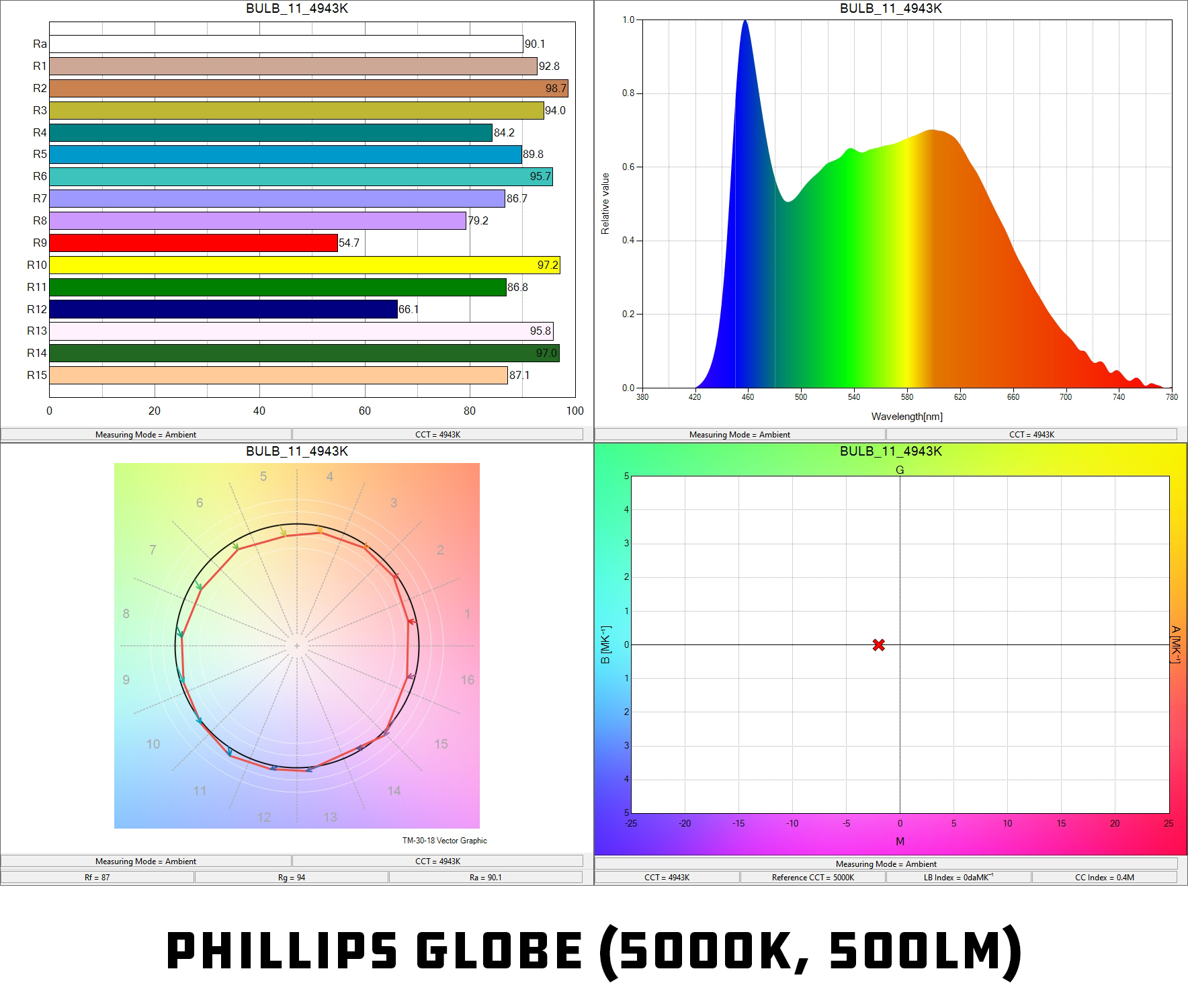
Phillips didn’t really impress me with any of their bulbs, but let’s kick it off with this big globe thing. All of the other bulbs tested look almost identical (which sort of is why I wanted to do this test) but this one is in a relatively large-by-comparison, plastic-as-glass frosted globe. It’s got those fake “LED Filaments” in it, looking like short incense sticks. In any case, we’re seeing some skew on the TM30 chart, scoring an 87, and with an SSId of 69 we’re not wowing anyone. CRI of 90, TLCI of 88, whoopdeedoo. Wouldn’t use ‘em with other options available.
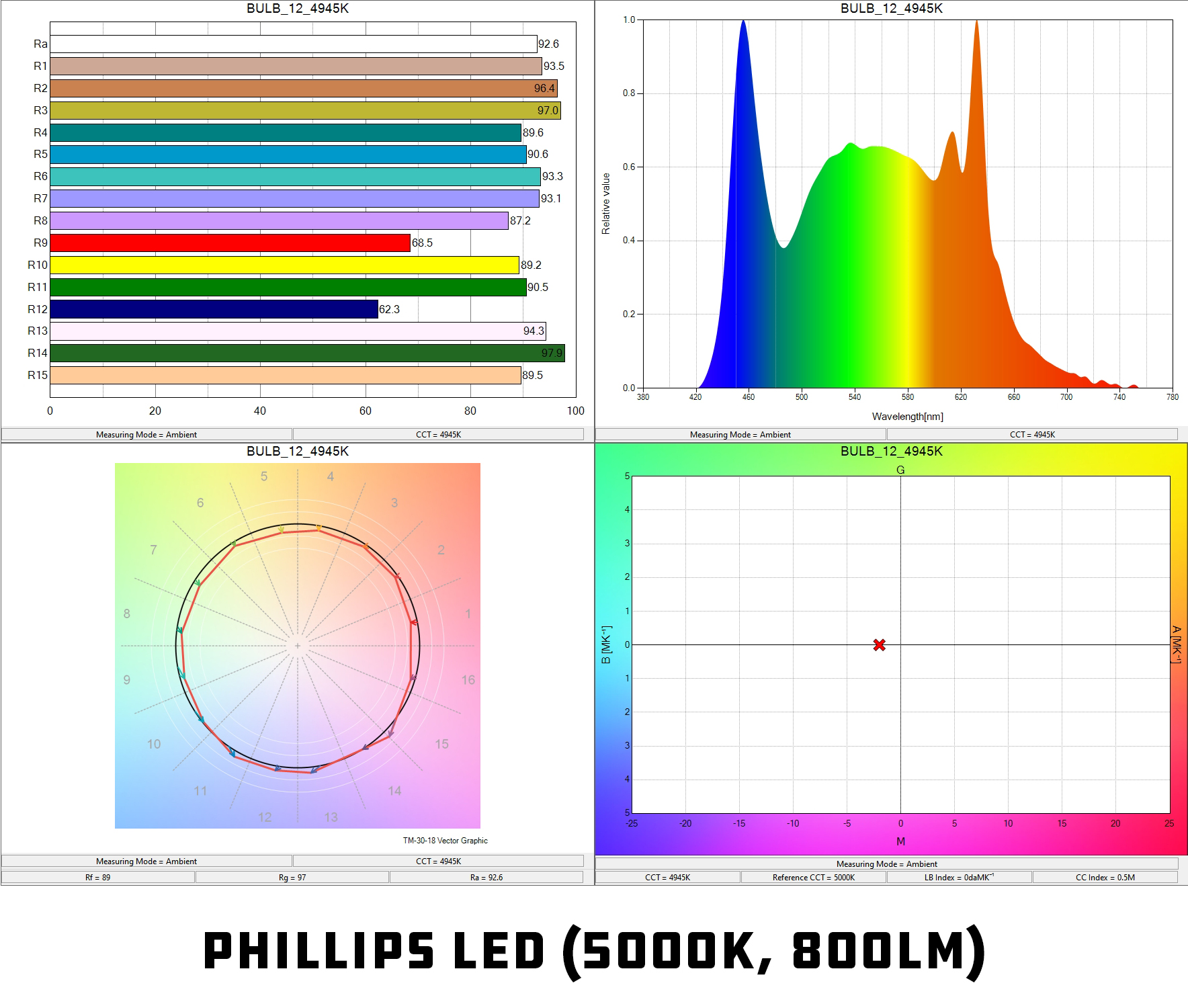
This one has the same “shell” as all the other bulbs and, while it’s almost better (?) it’s still not good. That random set of orange spikes doesn’t make too much sense, especially compared to the previous bulb that at least only had the single spike. A slightly better CRI of 92, a worse SSId of 66, and a nearly identical TLCI of 89 makes this another no. Vaguely better TM30 at 89 though, so… there’s that.
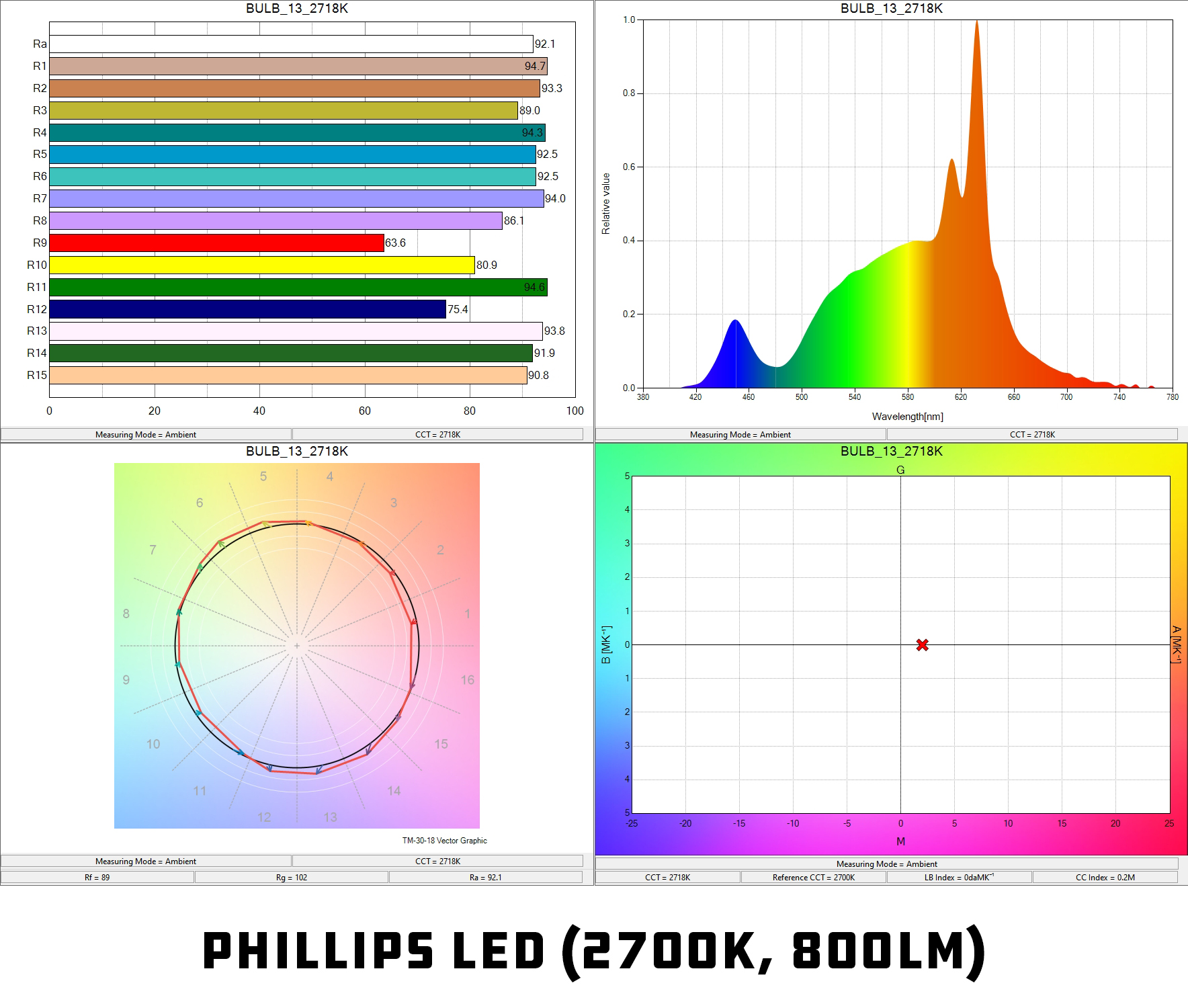
Here we’ve got the Tungsten-balanced version of the above light and hey look, our spike is still there! The temperature is essentially bang-on, only drifting by 18 Kelvin, but as we can see our spectrum is very off-putting and our accuracy is low. TLCI of 77, SSIt of 70, TM30 at 89, and a CRI of 92. This also goes to show why we can’t really trust CRI numbers, and should only be a concern if they’re low.
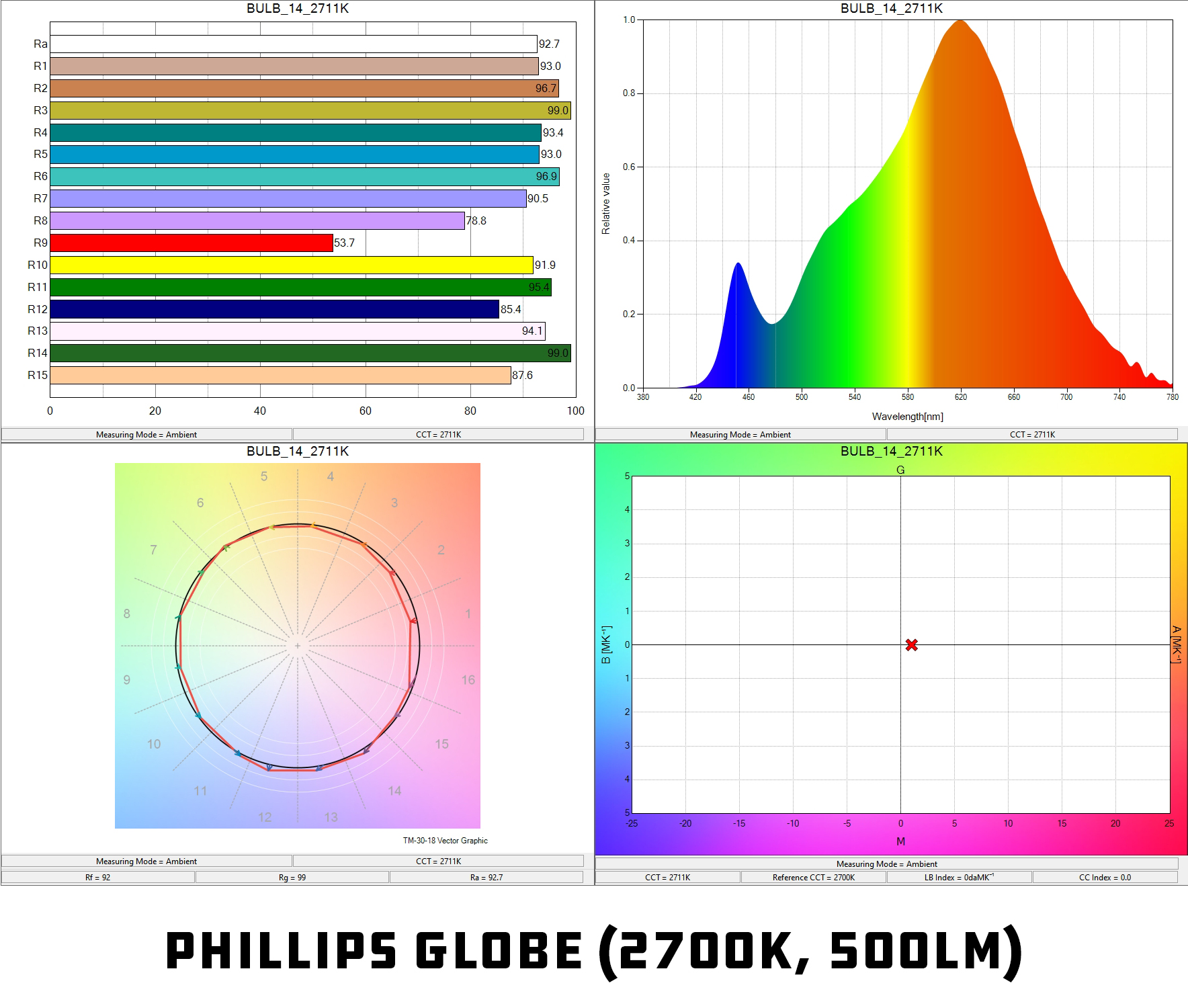
Our final bulb, the Tungsten version of the weird globe light is… good? The heck? SSIt of 81, TLCI of 89, CRI of 92 a TM30 of 92, and only 11K off the target CCT… what happened?! The spectrum even looks normal for an LED! Phillips… you confounding company you. Figure out what you did here, improve on it a little, and then make that happen for the rest of the lineup. At least your offerings at Ralph’s.
For your convenience, below I’ve made a chart of all the findings from this little test. I’d also like to highlight the fact that the real tungsten bulb got an SSIt of 88 and the actual sun got an SSId of 98, so… that’s information. Then again I didn’t let the Tungsten bulb warm up at all, just turned it on and metered, but still. This shows that nothing will likely hit the exact spectrum of an idealized light source, so let’s say anything over 85 is great for that metric. To reiterate, we’re generally most concerned with the TLCI and TM30 of each bulb for cinema use, but the SSI is an interesting metric just for knowing what the “ideal” would be, spectrally speaking, if trying to replicate true Tungsten or Daylight.
| TLCI | TM30 (Rf) | SSIt/SSId | ΔTarget Kelvin | CRI (Ra) | |
| TUNGSTEN | 100 | 100 | 88/50 | -47K | 100 |
| DAYLIGHT | 100 | 99 | 58/98 | -13K | 99 |
| IKEA LEDARE | 90 | 93 | 81/46 | -48K | 94 |
| IKEA RYET | 77 | 89 | 70/36 | -15K | 93 |
| IKEA Random | 66 | 85 | 77/45 | -9K | 83 |
| LADWP #1 | 68 | 84 | 75/44 | -17K | 82 |
| LADWP #2 | 72 | 87 | 73/39 | -151K | 83 |
| YDJ Light | 72 | 87 | 75/42 | -73K | 84 |
| GE Sunfilled (D) | 99 | 98 | 65/84 | -22K | 98 |
| GE Sunfilled (T) | 95 | 95 | 86/48 | -4K | 97 |
| CREE (D) | 70 | 84 | 51/66 | -184K | 84 |
| CREE (T) | 87 | 92 | 77/45 | +48K | 95 |
| Phillips Globe (D) | 88 | 87 | 53/69 | -57K | 90 |
| Phillips Globe (T) | 89 | 92 | 81/47 | +11K | 93 |
| Phillips LED (D) | 89 | 89 | 52/66 | -55K | 93 |
| Phillips LED (T) | 77 | 89 | 70/37 | +18K | 92 |
So there you have it, a non-exhaustive but slightly representative look of what results you could expect if you were to use household bulbs for your next project. At the very least you now know what kind of bulb you should use in your practicals! My choice would obviously be the Sunfilled bulbs from GE, but the IKEA LEDARE and CREE Tungsten options aren’t bad. Whatever you do, don’t trust your local power company to supply you with the good stuff!
Like I said at the top, I’d be happy to go to a hardware store and buy out every bulb in the place if someone (Sekonic? Anyone?) would spot me the cash to test them all out for a more exhaustive list, but for now this’ll have to do. My next project is to head up to Filmtools at some point and test out all the actual film lights to see who’s leading the way there and who’s not cutting the proverbial ketchup. One thing I do know: the Skypanel results may surprise you!

Filmtools
Filmmakers go-to destination for pre-production, production & post production equipment!
Shop Now